AS business costs are driven ever lower, some companies are creating disruptive products that are simultaneously better and cheaper than existing products, right out of the gate. The upshot? Success for those who play by the new rules of strategy and competition — and disaster for incumbents who can’t adapt fast enough.
Nearly everything you think you know about strategy and innovation is wrong.
The most recent round of improvements in information technologies has changed the game once again, driving down costs and prices over time. The challenge now for innovators is to invent products so beloved by customers that they will pay more for them despite falling prices.
Given the time it takes to innovate, that can be a tall order. As a result, markets are being rocked by a new kind of offering — one that renders the traditional price-performance trade-off irrelevant. New products and services that exploit today’s power of IT now enter mainstream markets not only better but also cheaper. In today’s fully connected, always-on world, these new offerings are also better integrated with the way customers live and work (in strategy terms, they provide greater "customer intimacy"). And word of their superiority in all relevant dimensions now travels the globe in a flash, like the latest YouTube sensation.
The result: Entire product lines and whole markets are now being created or destroyed overnight. Say hello to "big-bang disrupters." Once launched, these disrupters are hard to fight. They don’t just create dilemmas for innovators. They trigger disasters.
Innovation on its head
Consider the smartphone, which has displaced a growing list of former standalone products, including digital cameras, calculators, organisers, alarm clocks, e-mail readers and, perhaps soon, handheld game devices, electronic book readers, video cameras and laptop computers.
When Google launched its free (perpetually) beta app Google Maps Navigation, the company was, as always, looking simply to drive more eyeballs to more advertisements by integrating more already-digital information. But from the outset, the app out-performed expensive, standalone GPS devices on every strategic dimension. It’s cheaper (that is, free); it’s constantly being updated and enhanced in real time; and it offers a more customer-intimate solution by connecting with other smartphone apps, including search results, maps, mail and contacts.
Little surprise, then, that the major players in the GPS device market lost as much as 85% of their market cap in the 18 months after the Google Maps Navigation introduction. Bang!
Industries at risk
The reality of big-bang disruption is increasingly obvious to anyone haunting the coffee shops and venture capital conference rooms in innovation hubs from Silicon Valley to Singapore. What is simply cool for these young entrepreneurs can be devastating for incumbents in industries that don’t, and perhaps can’t, see big-bang disruptions coming until it’s too late.
Rapid take-up
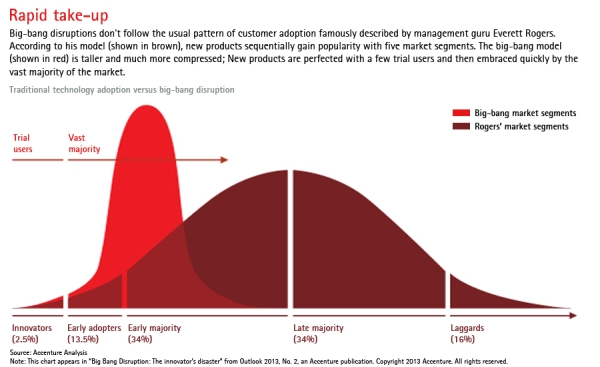
The bitter lesson learned: Today’s innovations come out of left field, combining technologies seemingly unrelated to a company’s offerings, to achieve a dramatically better value proposition.
Big-bang disrupters may not even see the incumbents as competition. Disrupters don’t share the incumbents’ approach to solving customer needs, and they’re not interested in offering a slightly better price or performance with hopes of gaining a short-term advantage. Usually, they’re just tossing something shiny at consumers, hoping to attract them to a completely different business.
While this new style of devastation is starting to be recognised in such information-intensive industries as consumer electronics, software and retailing, every industry is at risk. That’s because information is increasingly the last remaining source of competitive advantage in a wide range of industries, including automobiles, financial services, education, food and other commodity goods.
Disruption is now attacking even hard-asset businesses. Consider the impact of new smartphone-based applications such as Lyft, SideCar and Uber on mature taxi and limousine services. These new businesses allow customers to order and pay for rides with a mobile device, track dispatched rides using location services and rate the driver after each trip.
Nothing about the new services is proprietary or particularly hard to duplicate. But the common response of incumbents so far has been to focus their efforts on convincing regulators to ban the new entrants rather than figure out how to compete with them. That response is both predictable and stereotypical. It is also counterproductive. Customers have been quickly galvanised through social media to fight back — so far, successfully.
Regulated industries are especially vulnerable to information-driven big-bang disrupters. When the law implicitly or explicitly limits internal competition and bars new entrants, businesses have little, if any, incentive to innovate. Taxi service is just one example. Countless other industry sectors have also fallen far behind the digital revolution. And once the disrupter finds a way in, the collapse is that much Regulated industries are especially vulnerable to information-driven big-bang disrupters. When the law implicitly or explicitly limits internal competition and bars new entrants, businesses have little, if any, incentive to innovate. Taxi service is just one example. Countless other industry sectors have also fallen far behind the digital revolution. And once the disrupter finds a way in, the collapse is that much more sudden.
In Accenture’s ongoing study of the phenomenon, we have already identified big-bang disruption in more than 30 industry segments that cross all economic sectors.
Lawbreakers
A generation of executives has been schooled in the iron law that says companies must pursue one "strategic discipline" at a time — they can aim to be the low-cost producer, the innovation leader or the most customer-intimate, but not all three at once. Big-bang disrupters, who are often entrepreneurs with little training and even less business experience to unlearn, present a stark contrast. They are, to coin a phrase, thoroughly undisciplined.
For decades, strategists were taught to focus with religious intensity on only one dimension of strategy, or they risked, as strategy guru Michael Porter famously said, getting "stuck in the middle."
Today, innovators are no longer bound by this orthodoxy. Thanks to advances in IT and development platforms, the costs of innovation have declined dramatically. Innovators can now experiment, cheaply and rapidly, directly in the market using off-the-shelf component technologies. And because each of those components will soon be cheaper, they can keep their per-unit innovation costs lower than the predictable decline in production and delivery costs. Voilà: better and cheaper.
Couple in-the-market development with modular and platform-based interconnectivity, and you have an offering that is almost certain to be highly customer-intimate as well.
Likewise, followers of innovation pioneer Clayton Christensen have been trained to look for disruptive technologies in the form of lower-quality substitutes that enter mainstream markets first by picking off a company’s worst customers and then, as technology improves, by moving up to become competitive.
Under Christensen’s approach, executives who saw the early signs of disruption had time to respond. They could avoid what Christensen called "the innovator’s dilemma" by starting internal skunk-works projects to test the disrupter and get ready to shift when price and performance made the product acceptable to mainstream customers.
But now that technology platforms make mass distribution instantaneous and empower consumers to benefit from near-perfect market information from the most trusted source of all — one another — the pace of the solutions recommended by Christensen proves catastrophic.
Winners take all
Consider as well the impact on marketing. Following the long-venerated innovation dissemination model of sociologist and theorist Everett Rogers, Geoffrey Moore wrote in the 1990s that successful new-product introductions followed five discrete stages, moving from early adopters to mainstream users, but only after crossing a marketing "chasm" in which the sell message changes from the new and exciting to the familiar and incremental.
Big-bang disrupters, however, enter the market in only two stages — first to trial users (who are often de facto co-developers and co-funders) and then to everyone else. Because they need not weigh the strategic trade-offs of an incumbent’s new offering, big-bang disruptions can be marketed to every segment simultaneously, right from the start. When the iPad arrived, it wasn’t just for people who couldn’t afford a laptop. Every millionaire wanted one too. Winner-take-all markets are often the result where even the second-place business in the sector fails to see high profit margins. Take the example of Sharp Corp., the once-dominant maker of LCD panels. The electronics company saw a severe decline in its share price in 2012, due in part to its underperforming television business, despite the fact that its products compare favourably with those of the manufacturer that consumers rate highest on most online evaluation sites.
But the path is not always smooth for successful big-bang disrupters, and they often leave the market as rapidly as they entered it. Instead of a gradual decline as markets mature, the crash comes quickly. Consumers have become accustomed to astonishing products, and are always poised for the next better-on-all-dimensions innovation. As industries fade into the sunset, a lone incumbent, serving a market for nostalgic customers, may yet find a profitable niche. Still, such a market is rarely little more than a shadow of the original.
More bucks for your bang
To survive — and even thrive — amid big-bang disruption, companies must learn the new rules of strategy and competition. The key is to understand the new lifecycle of innovation, which loosely follows the metaphor of the big-bang theory of the universe. The new cycle consists of four parts: the slow drawing together of matter and energy (the Singularity), the explosion and expansion (the Big Bang), the collapse of what’s known (the Big Crunch) and the calm before the next storm (Entropy).
The Singularity: Find a truth teller
To combat the failure of traditional competitive intelligence, senior executives must find their "truth tellers."
Big-bang disruption happens in large part because experimentation with a wide range of new, often off-the-shelf component technologies has become both low-cost and low-risk. Many, many failures are likely before the right combination is found and proven to be cost-effective. Often, the winning innovation is simply the one that combines the right technologies at the right time with a new way of doing business. Think, for example, of Amazon.com’s success with the Kindle, which came only after years of failed e-reader products that had both the wrong hardware and the wrong business model.
For incumbents, the failed early experiments send false signals, lulling executives into the misguided belief that the disrupters are not ready for prime time. Rather, direct market tests are often, perhaps unconsciously, like artillery barrages. They are "walking their fire" onto the real target, step by step, homing in on the right combination of technologies and business model that will, once launched, suddenly disrupt mature markets and dismantle long-stable supply chains. It is then that they level their full barrage.
Enter the truth tellers. These are industry experts with profound insights into new technologies and customer behaviours, who can predict earlier than anyone else when small tremors signal imminent earthquakes. Often, they are people who spend their careers working in the industry, and share a unique passion for its mission, its products and its customers.
One example is the North American executive of a Japanese carmaker who drove the company’s decision to launch a new brand of luxury vehicles, based on his insight into fundamental shifts in income and spending in the US market. His truth telling played an essential role in the carmaker’s ongoing operations at the time.
Truth tellers — named for the characters on soap operas who move the plot forward by revealing big secrets — are often eccentric and difficult to manage. They speak a strange language, one that isn’t focused on incremental change and the next quarter’s results. As a result, they may be found outside your organisation — they may even be customers. Learning to find them is hard. Learning to listen to them is even harder.
The Big Bang: Exploit near-perfect market information
Big-bang disruption, once created, enters the mass market at ultra-high speed. Instead of a slow, predictable process involving several discrete, sequential market segments — like the five-stage technology adoption curve model made famous by Everett Rogers — big-bang disrupters need worry only about two main categories of users: what we call trial users, and everybody else. In this stage, the goal is selling to everyone else — and fast. The sudden success of big-bang disrupters is driven by easy access to market opinion, facts and comparison data, which creates something ever closer to consensus market opinion. The same platform that developers use to create and deliver their disruptions is now also used by consumers to communicate with one another to determine their shared judgment. With ubiquitous and mobile networks, retailing all manner of goods and services has entered a new world. Rather than sellers broadcasting select information to potential customers, consumers now pull information from other consumers on price, quality and customer service, whenever and wherever they are. Advertising is both customised and timely, and often comes in the form of trusted referrals.
That means when the right combination of component technologies and business innovations comes together, everyone knows about it instantly. Takeoff is immediate, and vertical. The model of the innovator’s dilemma no longer applies; now, for incumbents, it’s the line of sudden death (see chart).
The end of conventional wisdom
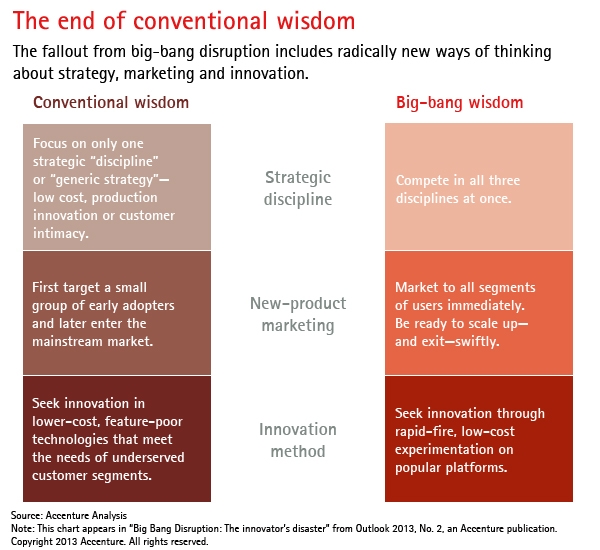
The availability of near-perfect market information also means consumers make fewer mistakes. They don’t buy a mediocre product simply because manufacturers invest in more advertising. They wait until the right version — smartphones, 3D televisions, electric cars, solar power — emerges. Almost-there versions don’t sell poorly — they don’t sell at all.
Maintaining an intimate connection to trial users — the co-developers and, thanks to crowdsourcing services such as Kickstarter, co-funders — is therefore critical. The new development model creates early users with a vested interest in new products, building intense loyalty to the concept, if not to a particular implementation.
Take, for example, the "smarthome" initiative of consumer electronics company Belkin International. Known as WeMo, the smartphone and tablet application has been designed to enable users to create specific commands for on/off switches of basic home functions and electronics, like lights. The company solicits and publishes user ideas for commands on its website, and when commands become popular enough — such as "If the Weather Channel says the sun has set, then have WeMo switch on the lights" — Belkin integrates them into the app’s default list of commands for all WeMo users.
The Big Crunch: Collar your risk
Not everyone is swept away by the onslaught of a big-bang disrupter. Some companies do survive, in many cases emerging in the new version of the industry in a position of greater leverage and profitability. But how?
The first step requires tough-minded management, sufficiently steeped in big-bang strategy, that can quickly overcome the emotional response to traumatic change and take decisive action. Assets must be shed, products must be retired, business models allowed to sunset. Only then can incumbents unlock the hidden value of core, often intangible, assets.
Incumbents are trapped by their balance sheets. Traditional accounting still leads management to concentrate on the value of hard assets rather than expertise, brands, patents and human resources. But in a fight against big-bang disruption, intangibles are often the most valuable assets incumbents have — perhaps the only ones that don’t quickly become liabilities. Knowing what they are and understanding their true worth can make all the difference.
A big-bang disruption sets off a rapid decline in the value of physical assets. To compete with undisciplined competitors, incumbents must prepare for the immediate evacuation of current markets and be ready to liquidate once-strategic assets. It’s important not only to shed mature technologies that will rapidly become obsolete but to do so before they become worthless.
In the semiconductor industry, for example, fabricators are now hedging investments in new capacity by contracting to sell plants at a future time and price, often before those plants are even built.
Return on residual assets can be time-sensitive, to say the least. Even for the innovators — or perhaps especially for them — collaring risk early on is essential to surviving the shift to the next big-bang disruption.
A new kind of diversification can also provide a valuable hedge against disruption. As industry change becomes less cyclical and more volatile, having a diverse set of businesses is vital. Industry leaders may have a hard time committing themselves fully to transformation, creating an opening for perennial second-banana incumbents to shed their assets first and take their expertise, brand and intellectual property into other industries where change is happening at a slower pace. When the film-based photo industry collapsed, it was Kodak, not Fujifilm Corp., that went bankrupt.
Entropy: Ride off into the sunset
In entropy, the big-bang process comes full circle. The old industry is dead, and a new one has risen from the ashes. Some incumbents are gone, new ones are created and supply chains are transformed into ecosystems. The new industry now waits for pressure to build and technology to advance through a new generation of failed market experiments, signaling the start of the next shift.
Companies must look closely at the phenomenon of industry sunset. How do assets get liquidated? How do old technologies and the facilities needed to manufacture and distribute them get recycled or retired? What financial tools are available to smooth the transition, even for industries that are "too big to fail"?
For industries in sunset, the entire supply chain is affected. Often, it is distributors, agents, retailers, financiers and others indirectly involved in the actual production of obsolete products who feel the full impact of big-bang disruption first and most acutely.
While smartphone makers now sell billions of products, that volume is dwarfed by those who sell the peripheral products — cases, headphones, chargers — and service contracts, network connections and apps, not to mention the component parts. All of these providers need to consider the potential big-bang disrupters of their fountainhead, and the need to balance the past with the possible future.
In the new diversification, the successful launch of a big-bang disruption only buys you a license to try again. And in doing so, your biggest competition becomes your own success. Serial big-bang disrupters effectively put themselves out of business first, emerging as new enterprises that share the same name but often little else. Successful brand associations and truth-teller networks may be their most valuable assets.
Vital to the new incumbents’ ability to launch more big-bang disruptions: leveraging disruptive technology and abstracting the business model (along with its marketing, human resources and IT systems) so that the business overall is reimagined as a platform for a wide range of other businesses — which companies such as Amazon have done successfully.
In the end, the collapse of the old market is as dramatic as the uptake of the new market. One incumbent often remains, servicing the needs of older customers and sentimentalists who buy or keep the old products out of a sense of nostalgia. But only one.
_____________________________________
As with any such change of this magnitude, we are only beginning to appreciate the myriad implications of the rise of big-bang disrupters. There are numerous details of strategy and risk management in each of the four phases that we have only begun to touch on here. Executives must ascertain the movement of disrupters in their own industries, and begin to put in place the capabilities necessary for success in a world that doesn’t play by the old rules of business.
Embracing the new rules that underpin a big-bang strategy is not for the faint of heart. It will take commitment, vision and a strong constitution. Because while big-bang disrupters are at times predictable, and their effects at times felt early, their ability to upend in an instant is profound. Business managers should heed the tacit warning given by a character in Ernest Hemingway’s novel, The Sun Also Rises, about the ways businesses fail. When asked how he went bankrupt, he replies, "Two ways. Gradually and then suddenly."
Further reading
"Big Bang Disruption," by Larry Downes and Paul F. Nunes, Harvard Business Review (March 2013)
"Accenture Technology Vision 2013: The Latest IT Trends and Innovations:"
"The Laws of Disruption: Harnessing the New Forces that Govern Life and Business in the Digital Age" by Larry Downes (Basic Books, 2009)
Big Bang Disruption on Facebook
About the authors
Paul F Nunes is the managing director of research for the Accenture Institute for High Performance. He is based in Boston.
Larry Downes, a fellow with the Accenture Institute for High Performance, is based in Silicon Valley.








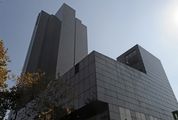







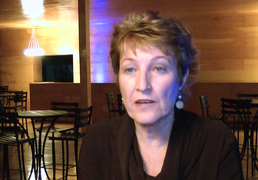
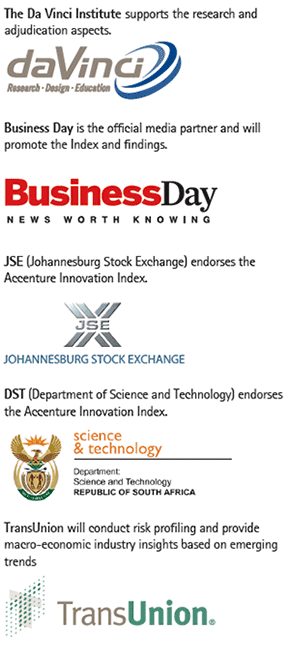




Change: -1.41%
Change: -1.63%
Change: -1.53%
Change: -1.58%
Change: -1.47%
Data supplied by Profile Data
Change: -0.64%
Change: 0.12%
Change: -1.41%
Change: 0.00%
Change: 0.10%
Data supplied by Profile Data
Change: 0.77%
Change: -0.33%
Change: 0.58%
Change: 0.96%
Change: 1.16%
Data supplied by Profile Data
Change: 0.73%
Change: 0.92%
Change: 0.19%
Change: 0.50%
Change: 0.05%
Data supplied by Profile Data